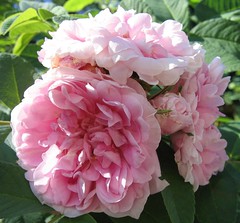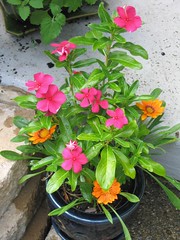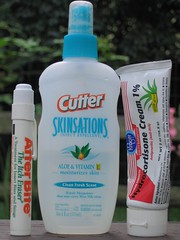I’m by no means a veteran of mail-ordering plants. This spring, I ordered my first plants from
Park’s. I’ll admit, I had visions of a Park’s van pulling up to the house and unloading 1-gallon potted plants from the back end. Go ahead and laugh, I was hopelessly naïve. I’ve now placed and received, two orders from Park’s and one from
Mulberry Creek. The following is a plant-by-plant review. None of them arrived in a nursery truck.
Clematis jackmanii: ordered from Park’s. It arrived via USPS in a cardboard box, cushioned with styrofoam peanuts. The three plants were in 2 inch pots. The plants themselves were between 3 and 8 inches high. The tall plant (8”) lost its top half from the shipping trauma. I planted them in the early spring. Two are doing well, between 3 and 4 feet tall now, and one is much smaller, but it looks healthy. I bought these from Park’s because I was impatient and the home improvement stores/nurseries didn’t have clematis yet (March). I was sorry when all the 1 gallon clematis started showing up for little more than the price of a 2-inch pot!
Bottom line: be patient and buy all of your clematis locally, in one-gallon containers.
Trumpet vine “Indian summer”: ordered from Park’s. It arrived with the clematis and also in 2 inch pots. They looked like dead sticks with roots. Because there were no leaves, there wasn’t much to be damaged. I planted them with the clematis. They didn’t leaf out until May or so, but have taken off like gangbusters since then. I’ve seen trumpet vine only rarely in the nurseries and it has always looked bedraggled.
Bottom line: I’m very happy with my trumpet vine from Parks. Maybe it will bloom next year?
Elfin Thyme: ordered from Mulberry Creek. It came via USPS. Each of the four 3-inch pots was cushioned inside a cardboard tube. The plants were very healthy upon arrival. The nursery included a helpful, and amusing, sheet on adjusting my new babies to life outside the box. The thyme is
in the ground and spreading. It surprised me by blooming this year. The price was also good ($4/each).
Bottom line: Mulberry Creek makes me wish I was more of an herb gardener.
Heliotrope: ordered from Park’s. It arrived via USPS in a box cushioned with accordion folds of cardboard. The plants were not in pots, but rooted in a growing sponge (1 ½” diameter). The plants looked extraordinarily healthy and two were even blooming. A note from the grower (not Park’s, which is a distributor) was included on the proper care and planting of plants grown in a sponge. The health of these plants was a great contrast to the delphinium I was to receive next from Park’s (alas, must have been a different grower).
Bottom line: I was silly to buy an annual online. I could have bought heliotrope at the nursery that was three times the size and the same price. I should have shopped around first.
Delphinium: Ordered from Park’s. It arrived via USPS in a box with the styrofoam peanuts and in 2-inch pots, again. Upon unpacking, two plants looked dead (no foliage) and two were on the verge of death. I planted all four and the last two promptly died. I complained and Park’s gave me store credit.
Bottom line: I was grateful for the Park's guarantee, and I may try again, as the local delphinium selection is very slim.
I’ll soon have more plants to review. I’m waiting on a few shrubs (hardy gardenia, mock orange, and two varieties of hydrangea) and a vine (hardy jasmine) from Park’s. I should also mention that Park’s has had some problems with its suppliers. The heliotrope was delayed a few months and the jasmine, although ordered in March, isn’t scheduled to ship until September. The Park’s delays prompted me to try a new mail order nursery,
Van Dyck’s. I’ll have updates on the Van Dyck’s plants this spring.
Although I’ve been disappointed by the bruised or dead plants I’ve received, it is pretty amazing that they live through the postal service at all. From what I’ve seen, some sort of cardboard bracing protects the plants best. I still think a superior product would come from the back of a dedicated truck, but I suppose it is a long trip from South Carolina (Park’s Garden’s home) to Cincinnati, OH.
 Roses are pretty and cottagey, but it is the fragrance that attracts me. In June, my Terese Bugnet covered itself in blossoms perfumed with the perfect rose scent. It’s continued to bloom sporadically and delight my nose over the course of the summer. I have enjoyed its perfume so much that I’m currently researching other, heavily fragrant roses to add to my garden. I welcome any suggestions! (Yves Piaget is a heavy contender for the new rose bed.)
Roses are pretty and cottagey, but it is the fragrance that attracts me. In June, my Terese Bugnet covered itself in blossoms perfumed with the perfect rose scent. It’s continued to bloom sporadically and delight my nose over the course of the summer. I have enjoyed its perfume so much that I’m currently researching other, heavily fragrant roses to add to my garden. I welcome any suggestions! (Yves Piaget is a heavy contender for the new rose bed.)














